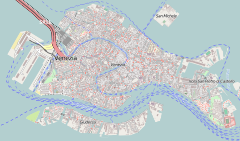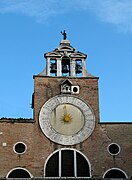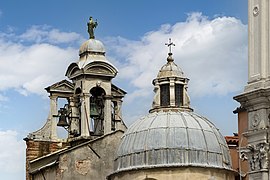
The Patriarchal Cathedral Basilica of Saint Mark, commonly known as St Mark's Basilica, is the cathedral church of the Catholic Patriarchate of Venice; it became the episcopal seat of the Patriarch of Venice in 1807, replacing the earlier cathedral of San Pietro di Castello. It is dedicated to and holds the relics of Saint Mark the Evangelist, the patron saint of the city.

The Grand Canal is a channel in Venice, Italy. It forms one of the major water-traffic corridors in the city.
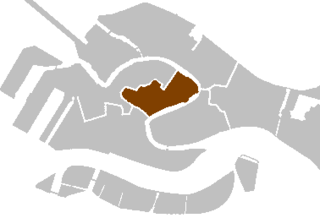
San Polo is the smallest and most central of the six sestieri of Venice, northern Italy, covering 86 acres (35 hectares) along the Grand Canal. It is one of the oldest parts of the city, having been settled before the ninth century, when it and San Marco formed part of the Realtine Islands. The sestiere is named for the Church of San Polo.

The Rialto is a central area of Venice, Italy, in the sestiere of San Polo. It is, and has been for many centuries, the financial and commercial heart of the city. Rialto is known for its prominent markets as well as for the monumental Rialto Bridge across the Grand Canal.
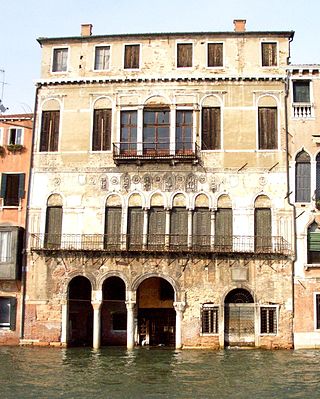
The Ca' da Mosto is a 13th-century, Venetian-Byzantine style palace, the oldest on the Grand Canal, located between the Rio dei Santi Apostoli and the Palazzo Bollani Erizzo, in the sestiere of Cannaregio in Venice, Italy. Today, it is home to the Venice Venice Hotel.
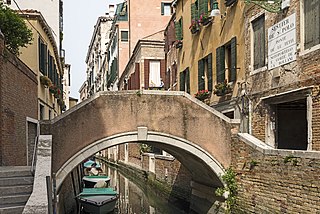
Ponte delle Tette is a small bridge over the Rio di San Canciano in the parish of San Cassiano, Venice, Italy, in the sestieres of San Polo. It takes its name from the use of the bridge by prostitutes, who were encouraged to stand topless on the bridge and in nearby windows to entice and convert suspected homosexuals.

Il Gobbo di Rialto is a marble statue of a hunchback found opposite the Church of San Giacomo di Rialto at the end of the Rialto in Venice. Sculpted by Pietro da Salò in the 16th century, the statue takes the form of a crouching, naked hunchback supporting a small flight of steps.

The Teatro San Cassiano was the first public opera theatre in Venice, inaugurated as such in 1637. The first mention of its construction dates back to 1581. The name with which it is best known comes from the parish in which it was located, San Cassiano, in the Santa Croce district (‘sestiere’) not far from the Rialto.

The Palazzo Dario is a palace located between the Palazzo Barbaro Wolkoff and the narrow Rio delle Torreselle on the Grand Canal in the sestiere of Dorsoduro, of the city of Venice, Italy. The palace was built in the Venetian Gothic style and was renovated in Renaissance style.
The Chorus Association of Venetian Churches, often shortened to Chorus Association, is a cultural conservation organisation working within the city of Venice in Italy. It works to safeguard, conserve and restore the artistic, historical and cultural heritage contained within the sixteen Venetian churches that presently constitute its membership.
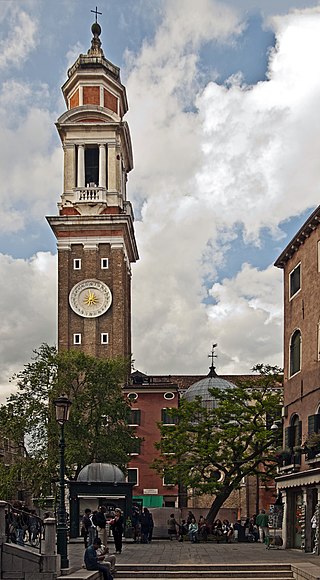
The Chiesa dei Santi Apostoli di Cristo, commonly called San Apostoli, is a 7th-century Roman Catholic church located in the Cannaregio sestiere of the Italian city of Venice. It is one of the oldest churches in the city and has undergone numerous changes since its foundation. The present building is the result of a major reconstruction project which was undertaken in 1575. The church is notable particularly for the Cornaro Chapel, an important example of Early Renaissance architecture, added by Mauro Codussi during the 1490s. The chapel is the burial place of several members of the powerful Cornaro family, including Catherine Cornaro, Queen of Cyprus and Armenia. The church houses several works of art including pieces by Giambattista Tiepolo and Paolo Veronese.

The Basilica di San Pietro di Castello, commonly called San Pietro di Castello, is a Roman Catholic minor basilica of the Patriarch of Venice located in the Castello sestiere of the Italian city of Venice. The present building dates from the 16th century, but a church has stood on the site since at least the 7th century. From 1451 to 1807, it was the city's cathedral church, though hardly playing the usual dominant role of a cathedral, as it was overshadowed by the "state church" of San Marco and inconveniently located. During its history, the church has undergone a number of alterations and additions by some of Venice's most prominent architects. Andrea Palladio received his first commission in the city of Venice from the Patriarch Vincenzo Diedo to rebuild the facade and interior of St Pietro, but Diedo's death delayed the project.

Palazzo Belloni Battagia is a palace on the Canal Grande, Venice, northern Italy. It is located in the sestiere (district) of Santa Croce, between the Fondaco del Megio and Ca' Tron, near the church of San Stae.

San Fantin is a church in the sestiere of San Marco in Venice, Italy. It stands in front of the Fenice Theater and adjacent to the Ateneo Veneto.
The following is a timeline of the history of the city of Venice, Veneto, Italy.
Palazzo di Spagna a San Geremia, also known as Palazzo Frigerio is a palace located on the street Lista di Spagna street #168, once a canal but undergoing landfill in 1844, about midway down the street between the train station and the piazza of the church of San Geremia in the sestiere of Cannaregio, in Venice, Italy. In past centuries, this area of Venice became known for housing foreign embassies, which the secret-obsessed Republic of Venice wished to keep distant from its government buildings.
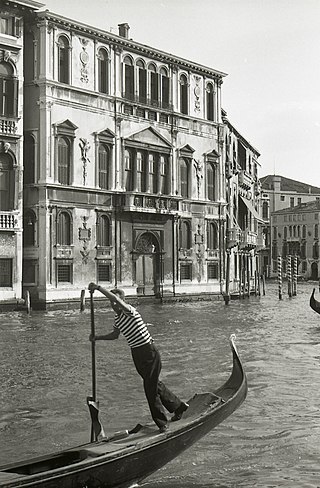
The Palazzo Contarini delle Figure is a Renaissance-style palace located between the Palazzo Mocenigo Ca' Vecchia and Palazzo Erizzo Nani Mocenigo, across the Grand Canal from the Palazzo Civran Grimani in the sestiere di San Marco in the city of Venice, Italy.

The Ca' Zenobio degli Armeni is a Baroque-style palace structure in the sestiere of Dorsoduro, in Venice, Italy. The nearby bridge Ponte del Soccorso connects it to the Palazzo Ariani.

Palazzo Querini Benzon is a palace in Venice located in the San Marco district and overlooking the Grand Canal. It is placed between the small Casa De Sprit and Casa Tornielli, at the confluence of the Ca' Michiel stream. Opposite are Palazzo Bernardo and Palazzo Querini Dubois.

The Venice State Archive, or State Archive of Venice, is located at Campo dei Frari, San Polo Venice.

